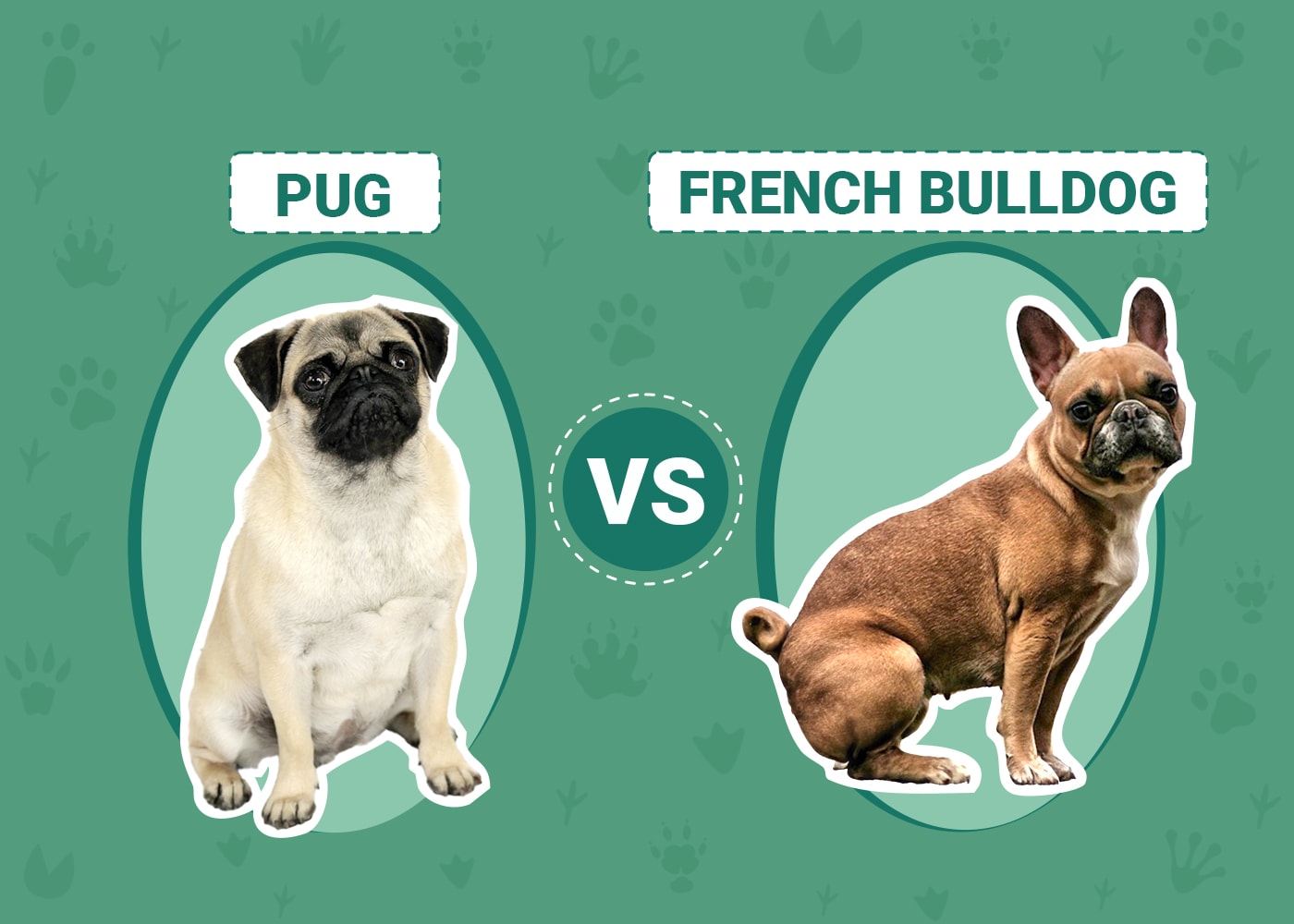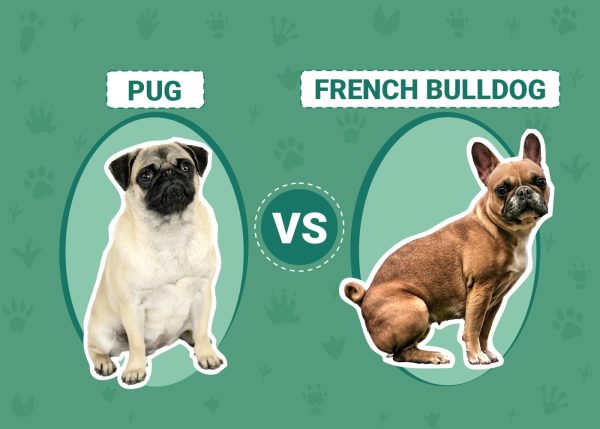Click to Skip Ahead
The decision of owning a small dog may find you choosing between Pugs and French Bulldogs. Both are lovable breeds with closely matching features. However, at a closer look, Pugs and French Bulldogs have diverse personalities and needs. Therefore, it is prudent to do a little research before choosing a breed.
Adored by royals from Chinese emperors to Queen Victoria, Pugs are small companion dogs. They originated from China and spread over to Europe through trade and treaties. Today, the easy to maintain furry friends are popular among celebrities.
Contrary to the second part of their name, French Bulldogs are not intimidating. In fact, they weigh only a few pounds, are adaptable, and are completely irresistible to dog lovers around the world. Also, contrary to their name, the breed originated from the UK and was imported to France by lace workers displaced from Nottingham, UK. In France, the dog was highly fashionable and became sought after by Parisian ladies, writers, and artists in the 19th and 20th centuries.
Continue reading to find out more about Pugs and French Bulldogs, and what their differences are.
Visual Differences
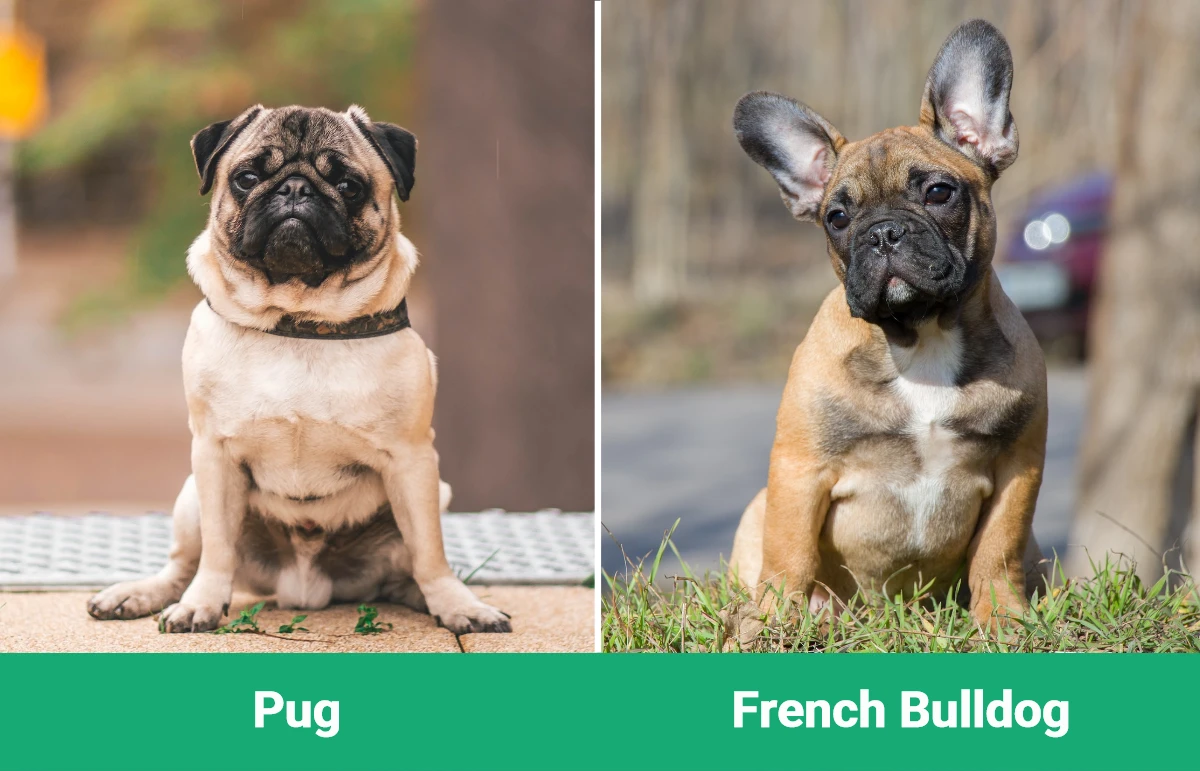
At a Glance
- Average height (adult): 10–13 inches
- Average weight (adult): 16–26 pounds
- Lifespan: 11–12 years
- Exercise: 20–40 mins a day
- Grooming needs: Low
- Family-friendly: Yes
- Other pet-friendly: Often
- Trainability: Curious, intelligent, loyal, mischievous
- Average height (adult): 12–15 inches
- Average weight (adult): 22–28 pounds
- Lifespan: 10–12 years
- Exercise: 20–40 mins a day
- Grooming needs: Low
- Family-friendly: Yes
- Other pet-friendly: Yes
- Trainability: Loving, intelligent, loyal, people pleaser
Pug Overview

Pugs are ancient dog breeds—mischievous but among the best pets. Over the years, they have acquired unique personalities and adapted to indoor life.
Personality/Character
Pugs have diverse personalities depending on genes and training. But when surrounded by a loving environment from birth, they will be great family dogs. The breed is content with a quiet indoor lifestyle and can spend long hours on your lap sitting quietly and only getting up to stretch or eat.
Pugs love to socialize. Socializing not only helps them live a healthy life but also prevents bad behavior. Introduce them to new people and sounds from an early age. At home, the dog will socialize and form strong bonds with almost anyone.
Training
Training Pugs may be a little complicated at the early stages, but with patience, training is fairly easy. Teach the pup basic obedience from an early age. Though Pugs can be stubborn, persistence and patience will produce the best results. Avoid harsh techniques and instead, reward your dog for positive behavior.
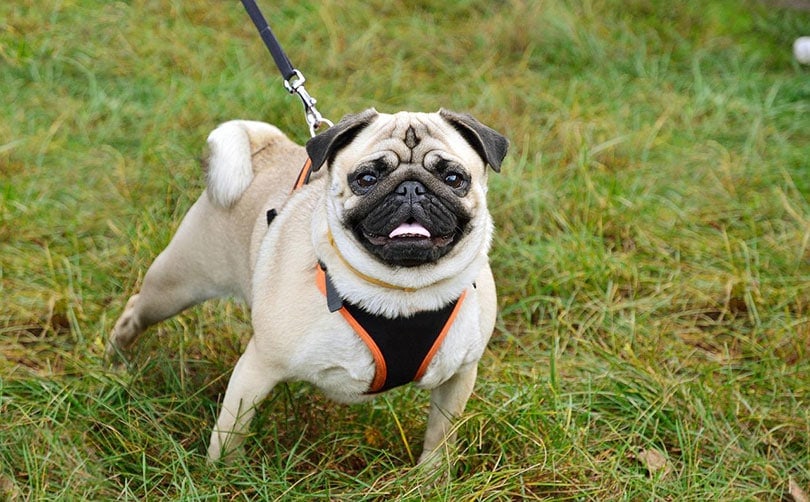
Breeding
Pugs can start breeding 9 months after they have attained sexual maturity. Any earlier than this is not recommended. For healthy and easy-to-train pups, select parents that have had a screening for genetic disorders.
Healthcare
Pugs have a strong immunity capable of keeping most diseases at bay. Unfortunately, the dog may inherit some genetic diseases or suffer from some health issues, including:
- Pug Dog Encephalitis (PDE)
PDE is a debilitating disease affecting small dogs such as Pugs. It affects around 1.2% of all Pugs, causing seizures, circling, confusion, general weakness, blindness, coma, and even death. Unfortunately, it is difficult to diagnose the autoimmune disorder and there is no cure for PDE other than selecting pups whose genes do not have the disease’s markers.
- Nerve degeneration
Nerve degeneration is synonymous with dementia in human beings. The disease affects Pugs aged 6+ and is characterized by loss of memory and mobility, especially in the hind legs. Researchers are yet to establish the disease’s cause, but it is mostly associated with age. Some medications may help alleviate the symptoms.
- Hemi-vertebrae
Hemi-vertebrae is a rare congenital malformation of the backbone of short-nosed dogs such as Pugs. Symptoms include uncoordinated gaits and, in worst cases, paralysis. The disease starts manifesting at around 6 months and may be treated through surgery.
Suitable For:
Being small dogs, Pugs are good companion animals suitable for both experienced and inexperienced pet parents. The dog is energetic, playful and is able to fit into a home instantly. If you have a young family, a Pug is a great choice.
French Bulldog Overview
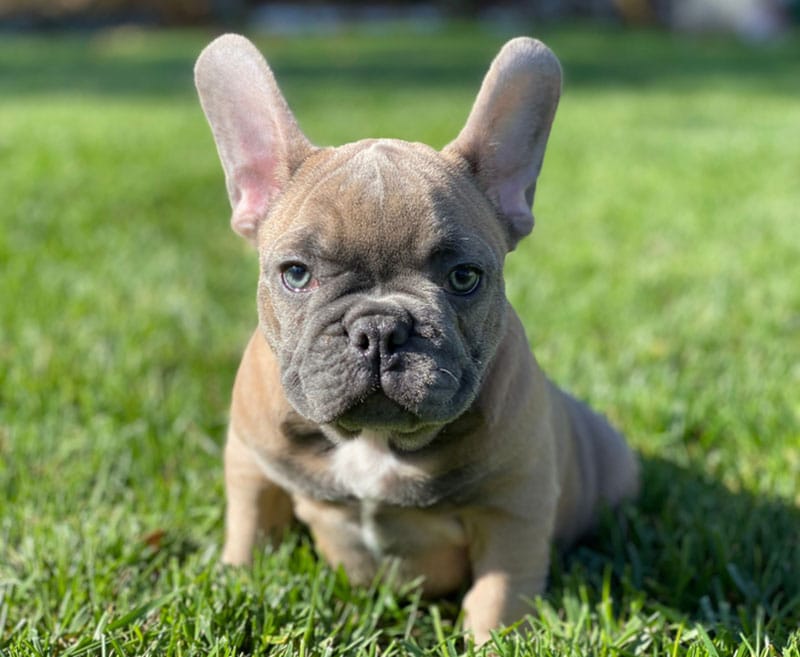
The American Kennel Club currently ranks French Bulldogs as the most popular dog breed in the world. Surprisingly, the dog topped the popularity ladder in 2022, toppling famous breeds like Labradors (which was the most popular breed for 30 years) and German Shepherds.
Personality/character
Pugs and French Bulldogs have very many related personality traits. Like Pugs, Frenchies have playful and trusting personalities which are manifested in how affectionate they are towards their owners. They sometimes cautiously extend the same level of affection toward neighbors and visitors.
While Pugs are livelier, Bulldogs are laid back. They may spend the whole day dozing on the couch, only barking when excited.
Training
Though Bulldogs are stubborn, their agreeability and intelligence make them easy to train. According to Stanley Cohen’s book, The Intelligence of Dogs, French Bulldogs are ranked 58th. Despite the average intelligence, a few exceptions, like Princess Jacqueline, exist. Jacqueline was a French Bulldog able to respond to 22 different words in appropriate situations.
To nurture your dog into the next Princess Jacquelin, start training as early as possible. Early training should be simple and kept as short, frequent sessions.

Breeding
Breeding Frenchies is not easy. Due to their unique physiology, almost all Frenchies are born via C-section. A female French Bulldog can technically breed at a year old, but because the cesarean and pregnancy can be stressful and difficult for her, it is recommended to wait at least 18 months before breeding.
Health
French Bulldogs face a host of potential health issues, certainly more than Pugs. This makes them expensive dogs to care for, and they’ll need regular vet checkups. Some issues to look out for are:
- Obesity
Obesity and being overweight are common problems in these dogs due to lack of exercise exacerbated by an indoor lifestyle. When a dog is obese, you cannot feel its ribs and waistline, and it is always tired and avoids exercise.
Correct the problem by regulating food intake and encouraging the dog to participate in exercise. 20 to 40 minutes a day is a great rule of thumb.
- Brachycephalic Obstructive Airway Syndrome (BOAS)
BOAS is a disorder of brachycephalic (flat-faced) dog breeds such as French Bulldogs. According to the Humane Society Veterinary Medical Association, almost 50% of French Bulldogs have significant signs of BOAS, whose symptoms include narrow nostrils and trachea 1. Treatment involves using anti-inflammatory drugs and even surgery.
Besides obesity and BOAS, these dogs are also susceptible to heat stroke, dermatitis, ear infections, and hip and elbow dysplasia.
Suitable For:
Frenchies rarely bark and are suitable for quiet indoor lifestyles. They are happy around singles as well as couples with kids. Additionally, the dog is very sociable and enjoys making new friends. Lastly, Bulldogs respect other pets and will happily share the same space.
Which Breed Is Right for You?
Pugs and French Bulldogs are both flat-faced dog breeds that share many characteristics. Even though Pugs are slightly temperamental and smaller than French Bulldogs, they are both ideal companion dogs. In terms of needs, both dogs require at least half an hour of exercise to prevent obesity, a well-balanced diet, and protection from heat.
Either breed is a great choice for families and singles alike, but Frenchies are prone to several health issues that can make caring for them expensive. If you’re looking for a small travel dog, the Pug is ideal. If you’re looking for a true stay-at-home companion, the French Bulldog may be a great option.
See Also:
- Pug vs Bulldog: Differences Explained (With Pictures)
- How Big Does a Pug Get (With Weight & Growth Chart)
Featured Image Credit: Top – Mykyta Telenkov, Unsplash | Bottom – Hasan Gulec, Pexels

